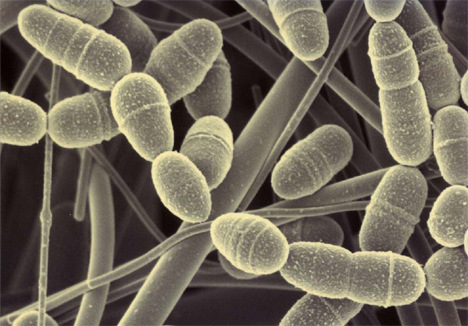Nature:美国印第安纳大学揭示是什么控制细菌形态的演化
美国印第安纳大学生物系的研究人员在新研究中发现spmX基因是对细胞形态有重要影响的一个发育调控因子。这一成果揭示细菌形态形成的一个分子机制。相关文章发表于2014年1月19日的《Nature》杂志上。

Nature:美国印第安纳大学揭示是什么控制细菌形态的演化
虽然细菌的形态有无数种,但对很多不同细菌形态的形成机制还很不了解。
在这项研究中,Yves Brun及同事发现Caulobacter 和 Asticcacaulis sp.两种细菌的spmX基因(它编码溶菌酶家族的定域化因子SpmX)是对细胞形态有重要影响的一个发育调控因子。SpmX决定向细胞被膜(cell envelope)的柄状延伸(stalk-like extension)的位置是在两极还是在两侧,而这两个位置分别是Caulobacter 和 Asticcacaulis的特点。
系统发生分析显示,spmX 一个特定区域的逐步演变导致一个新功能的获得和这一蛋白的定位,从而驱动“柄位置”(stalk position)的依次转变。
研究结果表明,蛋白功能的改变,增选以及模式化都是细菌形态演变的关键因素。因此,过渡形态相似的进化原则同时适用于单细胞原核生物和多细胞真核生物。
原文摘要:
Sequential evolution of bacterial morphology by co-option of a developmental regulator
Chao Jiang, Pamela J. B. Brown, Adrien Ducret & Yves V. Brun
What mechanisms underlie the transitions responsible for the diverse shapes observed in the living world? Although bacteria exhibit a myriad of morphologies, the mechanisms responsible for the evolution of bacterial cell shape are not understood. We investigated morphological diversity in a group of bacteria that synthesize an appendage-like extension of the cell envelope called the stalk. The location and number of stalks varies among species, as exemplified by three distinct subcellular positions of stalks within a rod-shaped cell body: polar in the genus Caulobacter and subpolar or bilateral in the genus Asticcacaulis. Here we show that a developmental regulator ofCaulobacter crescentus, SpmX, is co-opted in the genus Asticcacaulis to specify stalk synthesis either at the subpolar or bilateral positions. We also show that stepwise evolution of a specific region of SpmX led to the gain of a new function and localization of this protein, which drove the sequential transition in stalk positioning. Our results indicate that changes in protein function, co-option and modularity are key elements in the evolution of bacterial morphology. Therefore, similar evolutionary principles of morphological transitions apply to both single-celled prokaryotes and multicellular eukaryotes.

